Three Must-Try Souvlaki in Piraeus
In Drapetsona and Keratsini, family-run kebab...
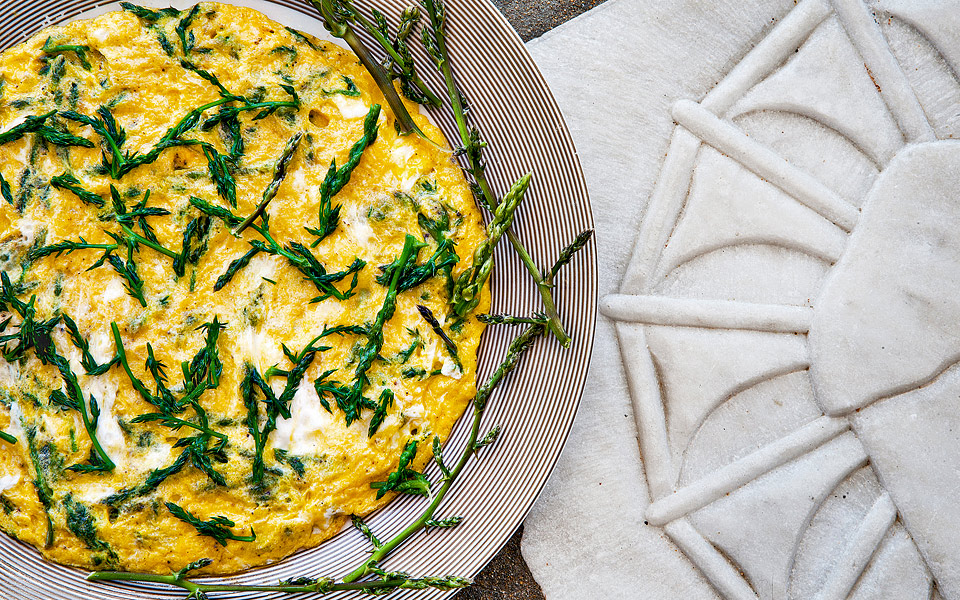
One of the local delicacies, omelet with cheese and wild esparangus
© Evelyn Foskolou
I happen to live in Mykonos, an island that many people dream of just visiting. I enjoy spending the morning in Gialos, the waterfront, with all the cafés. On most days, I cook up what I can get locally, either from the farmers at the small open-air market or from the marble stands at the fish market, where fishermen display the catch of the day. This way, I can follow the natural cycle of products, using them in the order they become available as the seasons change.
I was born here, back when tourism was still in its infancy. We had three good hotels in Chora, the main town, all located around the old port. Back then, you could still enjoy the fragrances of life. Around the neighborhoods, the ovens were all wood-burning, and the place was full of the smell of baking bread in the mornings and delectable oven-cooked foods at midday. There was no such thing as a ventilator, so the whole street would share the aromas emanating from the pots and pans in every kitchen, as homemakers prepared the main meal of the day. Quite often, someone would light a brazier somewhere in the back streets and grill up some small fish, such as bogues, combers or picarels. All you needed was a little olive oil, some sea salt and a freshly cut, sweet-smelling tomato to complete the definition of pleasure.
The patisseries were all in Chora. From them, the scent of cinnamon caramels, of toasted sesame or of rose water could make your mouth water. And along with the smells were the sounds. Every morning, the greengrocers would load their produce onto the donkeys and call out: “Tomatoes, eggplant, beans, watermelons, melooons…” dragging out the final vowel in a sing-song voice.
“Around the neighborhoods, the ovens were all wood-burning, and the place was full of the smell of baking bread in the mornings and delectable oven-cooked foods at midday. ”
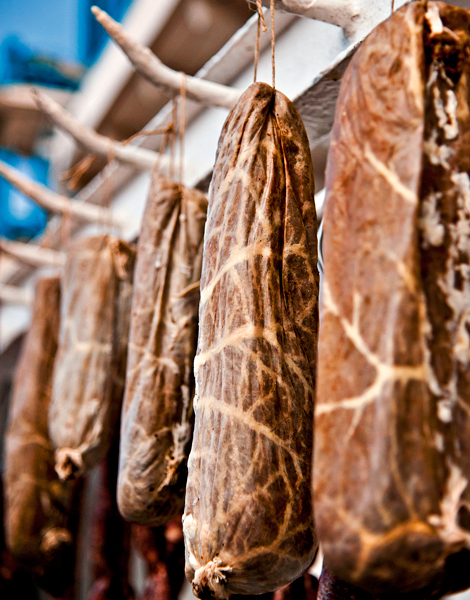
Pork louza is one of the finest Cycladic cured meats.
© Evelyn Foskolou
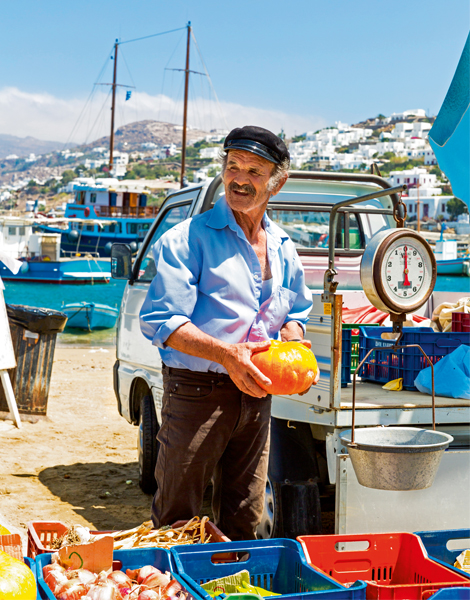
Local farmers are in Gialos (Chora) every morning with their fruit and vegetables.
© Dionysis Kouris
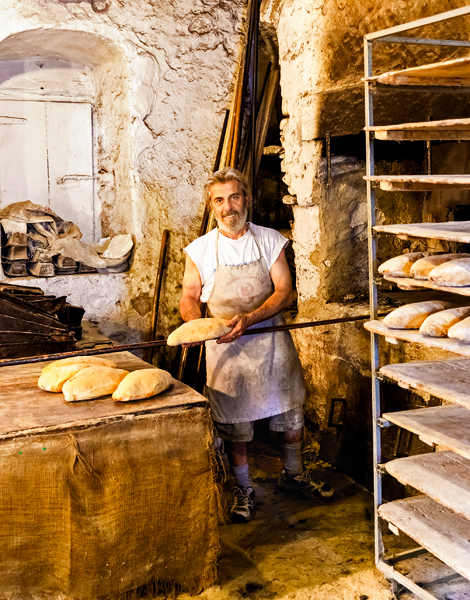
The wood-burning oven at “Gioras” bakery in Chora, Mykonos, is still used to produce sourdough bread, barley rusks, lazarakia sweet bread and others.
© Dionysis Kouris
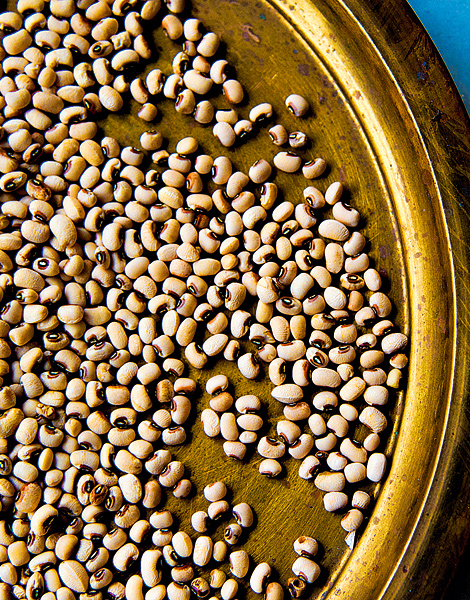
Brown-eyed beans in limited production but with plenty of flavor!
© Evelyn Foskolou
On Mykonos, making the most of local products is not some trend that caught on. It’s a necessity. Slowly but surely, society in general, led by business owners and citizen groups concerned with food, took the initiative to pay more attention to taste as a cultural element of the island.
The Gastronomy Club of Mykonos is a very dynamic group, active in food culture as it relates to local cooking customs and products. The Club works on ways to expand the use of these customs and products in contemporary catering by raising awareness of regional Greek cuisines and other popular cuisines. Their actions serve as a source of inspiration for chefs working on the island and participating in their events.
The Association of Amateur Grape and Olive Growers of Mykonos (ER.O.S) has a dual objective: to revive the viticulture of the island (over its 12 years of activity, it has distributed to its members more than 28,000 vines grafted with varietals native to Mykonos and the Cyclades), and to develop olive cultivation (12,000 olive tree seedlings have already been distributed).
The local harvest and the products of the season determined our gastronomic traditions and decided what we would eat at any given time. Nonetheless, a way was always found to create dishes that provided essential nutrients while also satisfying the human need for pleasure. The cuisine of Mykonos, indeed that of the Greek islands in general, has this dual function as part of its foundation.
The ingredients delineated our dietary habits: we never had an abundance of fruits and vegetables – the climate and harsh soil did not permit it – but what we did have were delicious. Our cheeses and meat were exceptional, too. We cured our meats in salt and matured them in the northerly wind, while the fish, well, it was whatever the sea had to offer.
Mykonos got along on these few things for many years. A relatively poor island until the 1960s, its specialty dishes included onion pie and honey pie, one savory and the other sweet, but both made using the local soft cheese tyrovolia; string beans served with a garlic dip; and dried Mykonos beans, which are small, tasty brown-eyed beans boiled with a little rice and flavored with sautéed onion, oil and vinegar. There were also the pork meatballs, with coarse ground meat flavored with summer savory and oregano; fritters made with greens, fennel and fish roe; and mostra rusks with a spicy local kopanisti cheese, tomato, olive oil and oregano that made a delicious appetizer to accompany a glass of ouzo. And there were the elegant almond-based sweets, too, but these were not often found in our humble working-class homes.
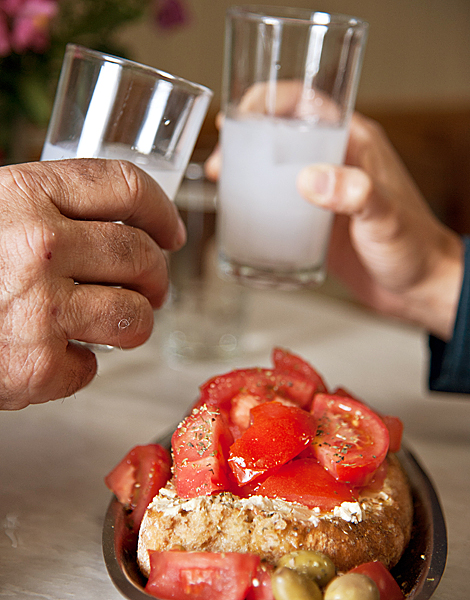
Mostra rusks with a spicy local kopanisti cheese, tomato, olive oil and oregano that made a delicious appetizer to accompany a glass of ouzo
© Evelyn Foskolou
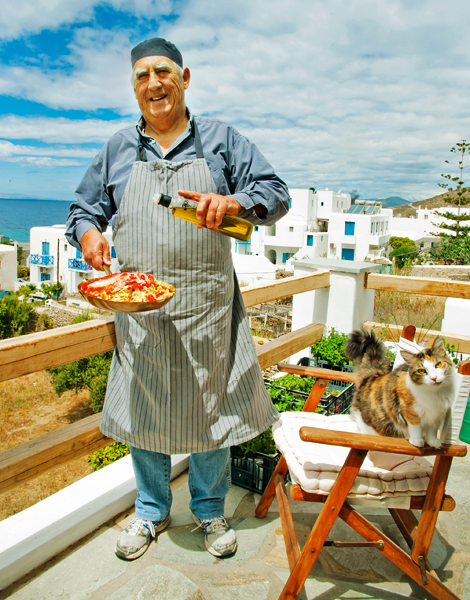
Giorgos Rizopoulos, owner of the legendary El Greco Restaurant, presents one of his most popular dishes, scorpion fish with pasta.
© Evelyn Foskolou
As the years passed, tourism gradually increased, bringing changes to everything, including the gastronomy. Nowadays, you will find some of the best restaurants in Greece right here in Mykonos, with notable chefs making use of a vast wealth of products (not just local ones, of course) and offering a wide array of flavors that you will be hard pressed to find elsewhere. In the last few years in particular, there has been a small but important revolution.
All of the information from research into dietary habits and the use of ingredients indicates that there is a supralocal cuisine forming across nearby islands, a culinary train with Santorini as the steam engine, Mykonos as the first-class carriage, and Tinos, Paros, Naxos and Sifnos there for the ride, too, all sharing the local gastronomy of the Cycladic islands. The result is an integrated sum of diverse parts with many common characteristics. The chef-engineers continuously supply the kitchen-steam engines with exquisite fuel in the form of traditional and modern dishes that impress a multi-cultural and constantly changing audience. I believe it won’t be long before Cycladic cuisine becomes a topic of conversation in all corners of the world.
Mykonos is an expensive place – both for holiday-makers and for permanent residents. The payback, though, is a pleasant lifestyle, vibrant summers, and the gentle beauty before and after the mild winter which many actively choose to experience. And so the food on the island is not cheap, either, but it is of high quality. The “tourist-trap” mentality, where inferior food is sold to unsuspecting tourists that will never be seen again, never really took hold here. Each year, large sums of money are invested in the food catering industry to maintain the high level of service that exists here, and despite the sheer volume of tourism and the cosmopolitan air of its visitors, the tastes that Mykonos offers have remained steadfastly local, unique and outstanding.
“I believe it won’t be long before Cycladic cuisine becomes a topic of conversation in all corners of the world.”
Born in Mykonos, Dimitris Rousounelos is an expert on Cycladic gastronomy, a writer of numerous books, a regular contributor of Gastronomos Magazine and an active promoter of the island’s products and food culture. He co-founded the Gastronomy Club of Mykonos.
In Drapetsona and Keratsini, family-run kebab...
From Santorini sunsets to ancient ruins,...
Francesca Chanioti, a home cook from...
Discover how Christos, Athens’ master souvlaki...